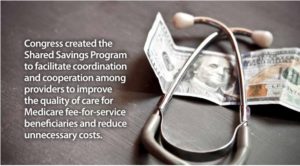MACRA nuts and bolts
Editor’s note: If your physicians are on edge these days, they have good reason to be. The Medicare Access and CHIP Reauthorization Act of 2015 – known as MACRA – will change the way they get paid for services rendered. Journal of Healthcare Contracting readers should be familiar with the law. But it’s long – almost 2,400 pages. Here’s a brief overview of the law. (Source: the Centers for Medicare and Medicaid Services)
 The Medicare Access and CHIP Reauthorization Act of 2015 (MACRA) repeals the Medicare Sustainable Growth Rate (SGR) methodology for updates to the Physician Fee Schedule (PFS). It replaces SGR – which was the cause for never-ending headaches in the physician community — with a new approach to payment called the Quality Payment Program. Simply put, the program is intended to encourage physicians to focus on care quality, rather than quantity of services provided.
The Medicare Access and CHIP Reauthorization Act of 2015 (MACRA) repeals the Medicare Sustainable Growth Rate (SGR) methodology for updates to the Physician Fee Schedule (PFS). It replaces SGR – which was the cause for never-ending headaches in the physician community — with a new approach to payment called the Quality Payment Program. Simply put, the program is intended to encourage physicians to focus on care quality, rather than quantity of services provided.
The Quality Payment Program rewards the delivery of high-quality patient care through two avenues:
- MIPS. The Merit-based Incentive Payment System consolidates components of three existing programs: the Physician Quality Reporting System (PQRS), the Physician Value-based Payment Modifier (VM), and the Medicare Electronic Health Record (EHR) Incentive Program for Eligible Professionals. But it will continue the focus on quality, cost, and use of certified EHR technology; and it will allow providers to earn a performance-based payment adjustment.
- Advanced APMs. Alternative Payment Models are payment approaches, developed in partnership with the clinician community, that provide added incentives to deliver high-quality and cost-efficient care. APMs can apply to a specific clinical condition, a care episode, or a population; and they allow the provider to earn an incentive payment for participating in an innovative payment model.
Providers can be part of the Quality Payment Program if they bill Medicare more than $30,000 a year and provide care for more than 100 Medicare patients a year, and are a physician, physician assistant, nurse practitioner, clinical nurse specialist or certified registered nurse anesthetist.
 The first performance period was to open Jan. 1, 2017, and close Dec. 31, 2017. During 2017, physician practices are instructed to record quality data and how they used technology to support their practice. If the practice decides to adopt Advanced APMs, it can provide care during the year through that model.
The first performance period was to open Jan. 1, 2017, and close Dec. 31, 2017. During 2017, physician practices are instructed to record quality data and how they used technology to support their practice. If the practice decides to adopt Advanced APMs, it can provide care during the year through that model.
Practices may earn a positive MIPS payment adjustment beginning Jan. 1, 2019, if they submit 2017 data by March 31, 2018. If they participate in an Advanced APM in 2017, they may earn a 5 percent incentive payment in 2019.
Practices may pick their pace for the Quality Payment Program. They can start collecting performance data on Jan. 1, 2017. But if they aren’t prepared to do so, they may start anytime between Jan. 1 and Oct. 2, 2017. Regardless of the start data, practices will need to send in performance data by March 31, 2018. The first payment adjustments based on performance go into effect on Jan. 1, 2019.
MIPS
Physicians electing to participate in traditional Medicare Part B, rather than an Advanced APM, will participate in the Merit-based Incentive Payment System, or MIPS, earning a performance-based payment adjustment to their Medicare payment.
Physicians earn a payment adjustment based on evidence-based and practice-specific quality data. To show evidence that they provided high-quality, efficient care supported by technology, they must send in information in the following categories:
- (60 percent). Replaces PQRS. Most participants will report up to six quality measures, including an outcome measure, for a minimum of 90 days. Groups using the web interface will report 15 quality measures for a full year.
- Advancing care information. (25 percent) Replaces the Medicare EHR incentive program, also called Meaningful Use. Some components: security risk analysis, e-prescribing, request/accept summary of care, etc.
- Improvement activities. (15 percent) Most participants must attest that they completed up to four improvement activities (e.g., expanded practice access, care coordination, patient safety and practice assessment, etc.) for a minimum of 90 days. Participants in certified patient-centered medical homes, comparable specialty practices, or an APM designated as a Medical Home Model will automatically earn full credit.
- A fourth category – cost — will be calculated from claims in 2017, but will not be used to determine the physician’s payment adjustment. In 2018, CMS will start using the cost category to determine payment adjustments.
APMs
An Alternative Payment Model, or APM, is a payment approach that gives added incentive payments to provide high-quality and cost-efficient care. APMs can apply to a specific clinical condition, a care episode, or a population.
Advanced APMs are a subset of APMs, and let practices earn more for taking on some risk related to their patients’ outcomes. Physicians may earn a 5 percent incentive payment by going further in improving patient care and taking on risk through an Advanced APM.
Anticipated models of Advanced APMs in 2017 are:
- Comprehensive ESRD Care (CEC). A two-sided risk, the Comprehensive ESRD Care (CEC) Model is designed to identify, test, and evaluate new ways to improve care for Medicare beneficiaries with end-stage Rrenal disease (ESRD). Through the CEC Model, CMS will partner with healthcare providers and suppliers to test the effectiveness of a new payment and service delivery model in providing beneficiaries with person-centered, high-quality care.
- Comprehensive Primary Care Plus. CPC+ is a national advanced primary care medical home model that aims to strengthen primary care through a regionally based multipayer payment reform and care delivery transformation. The multipayer payment redesign will give practices greater financial resources and flexibility to make appropriate investments to improve the quality and efficiency of care, and reduce unnecessary health care utilization. CPC+ will provide practices with a robust learning system, as well as actionable patient-level cost and utilization data feedback, to guide their decision-making. CPC+ is a five-year model that was scheduled to begin in January 2017.
- Next Generation ACO Model. Building upon experience from the Pioneer ACO Model and the Medicare Shared Savings Program, the Next Generation ACO Model offers a new opportunity in accountable care—one that sets predictable financial targets, enables providers and beneficiaries greater opportunities to coordinate care, and aims to attain the highest quality standards of care.
- The Medicare Shared Savings Program. Congress created the Shared Savings Program to facilitate coordination and cooperation among providers to improve the quality of care for Medicare fee-for-service beneficiaries and reduce unnecessary costs. Eligible providers, hospitals, and suppliers may participate in the Shared Savings Program by creating or participating in an Accountable Care Organization (ACO).
- Oncology Care Model. Under the Oncology Care Model (OCM), physician practices have entered into payment arrangements that include financial and performance accountability for episodes of care surrounding chemotherapy administration to cancer patients. The Centers for Medicare and Medicaid Services (CMS) is also partnering with commercial payers in the model. The practices participating in OCM have committed to providing enhanced services to Medicare beneficiaries such as care coordination, navigation, and national treatment guidelines for care.
To review an Executive Summary of the Quality Payment Program, published by the Centers for Medicare & Medicaid Services on Oct. 14, 2016, go to https://qpp.cms.gov/docs/QPP_Executive_Summary_of_Final_Rule.pdf
MACRA good for primary care doctors: American College of Physicians
The American College of Physicians (ACP) applauded the Centers for Medicare and Medicaid Services for including several initiatives to support high-value primary care in its 2017 Medicare Physician Fee Schedule final rule. “The policies in the rule more accurately recognize the work of primary care physicians and other cognitive specialties to accommodate the changing needs of Medicare beneficiaries,” said Nitin S. Damle, MD, MS, MACP, president of the ACP, in a statement. ACP members include 148,000 internists, related subspecialists, and medical students
ACP noted steps taken by CMS to support primary care, reduce barriers to chronic care management, improve access to behavioral health services, and prevention, including:
- Payment for care coordination by primary care physicians. The final rule will help reduce barriers to effective care of patients with chronic illnesses by allowing payment for more complex, time-intensive chronic care management (CCM) services, according to ACP. The College supports CMS’ removal of the health information technology requirements necessary to bill CCM codes.
- Addressing undervaluation of primary care services. The new rule adopts current procedural terminology (CPT) guidelines for separate payments for non-face-to-face prolonged services.
- Cognitive impairment care assessment and planning. The final rule lays down a new code and policies to pay for cognitive and functional assessment and care planning for patients with cognitive impairment (e.g., for patients with Alzheimer’s).
- Integrating mental and behavioral health into team-based primary care. CMS is implementing a new evidence-based approach to caring for patients with behavioral health conditions through the Psychiatric Collaborative Care Model (CoCM) as well as the expansion of the Medicare Diabetes Prevention Program – allowing Medicare beneficiaries to access preventive diabetes services without being subject to co-payments while providing participating physicians and other clinicians additional payments for furnishing preventive services to eligible beneficiaries.
